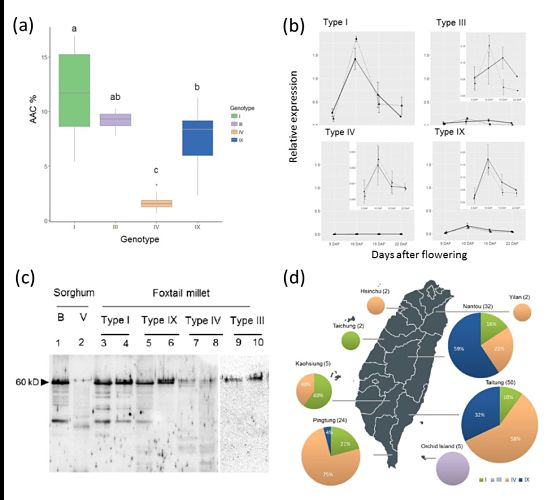臺灣農業瑰寶——
原住民傳統農耕與作物資源有利小米新品種育成
臺灣原住民的農耕歷史悠久,至今仍保留著部分傳統農耕制度與作物遺傳資源。台大農藝系教授林彥蓉帶領博士班學生巴清雄深入研究小米作物,發現各部落對種植小米偏好不同,有利於後續廣適應性小米新品種之育成,而原住民農耕資產在面臨氣候變遷之時,更能夠提供良好的對策。
巴清雄身為魯凱族人,以原鄉部落屏東縣霧台部落為研究對象,針對農耕制度進行訪談調查,包括部落詳細的週年耕作活動年曆以及主要作物整年於田間的消長。他表示,霧台部落保留傳統農耕,為多物種、多品系,搭配季節混作、輪作、間作的耕作制度,仍呈現早期自給式農業的樣貌,傳統農耕在山區原鄉部落的永續發展中扮演著十分重要的角色(圖一)。而小米是原住民重要的糧食與祭祀作物,在臺灣已經栽培5000年之久,各個語族或部落對於小米的偏好不同,因此保留下來的地方品系之遺傳歧異度很大,有利於後續廣適應性小米新品種之育成。此研究結果發表於SSCI期刊(Sustainability 10(10), 3370)。

圖一:(a) 10種主要作物整年於間作田的生長;(b) 霧台傳統農耕面積變化(Ba et al., 2018)。
此外,林彥蓉教授與學生也蒐集了臺灣小米品系,經由小米米質 (直鏈澱粉含量)與糯性基因之基因型與功能分析,釐清糯性基因與直鏈澱粉含量的關係 (圖二)。而基因型的地理分布與不同部落之使用特性 (人擇)高度相關,並呼應蘭嶼達悟族的小米的使用與本島不同,達悟族和本島之聯繫不若與菲律賓之巴丹島和日本南西群島之頻繁。此研究成果發表於SCI期刊(PLoS One. 2018, 13(12):e0210025)。

圖二:(a) 各糯性基因型的直鏈澱粉含量分布;(b) 各糯性基因型的Wx基因表現量;(c) 各糯性基因型的GBSSI免疫轉漬;(d) 各糯性基因型於台灣的地理分布(Kuo et al., 2018)。
Aboriginal Traditional Farming and Crop Resources Are Beneficial to The Breeding of New Varieties of Millet
Professor Yan-Rong Lin from the Department of Agronomy led a PhD student Qing-Xiong Ba to conduct an in-depth study of millet crops. They found that different tribes have different preferences for planting millet, which was conducive to the subsequent breeding of new varieties of widely adaptable millet. These aboriginal farming assets can provide good countermeasures even in the face of global climate change. Professor Lin and her PhD student also collected Taiwanese millet strains, and analyzed the genotype and function of millet quality (amylose content) and waxy genes to clarify the relationship between them (as shown in the Figure). The geographical distribution of genotypes is highly correlated with the anthropogenic use characteristics of different tribes. For example, the use of millet by the Dawu people in Lanyu Island is different from that of the main island, and more distinct than the use from the Batan Island of Philippines and the South West Islands of Japan.
The research was published in the PLoS One journal (2018, 13(12):e0210025).
.jpg)
Figure. (a) Growth of ten major crops in intercropping fields throughout the year; (b) Changes in traditional farming areas in Wutai (Ba et al., 2018).